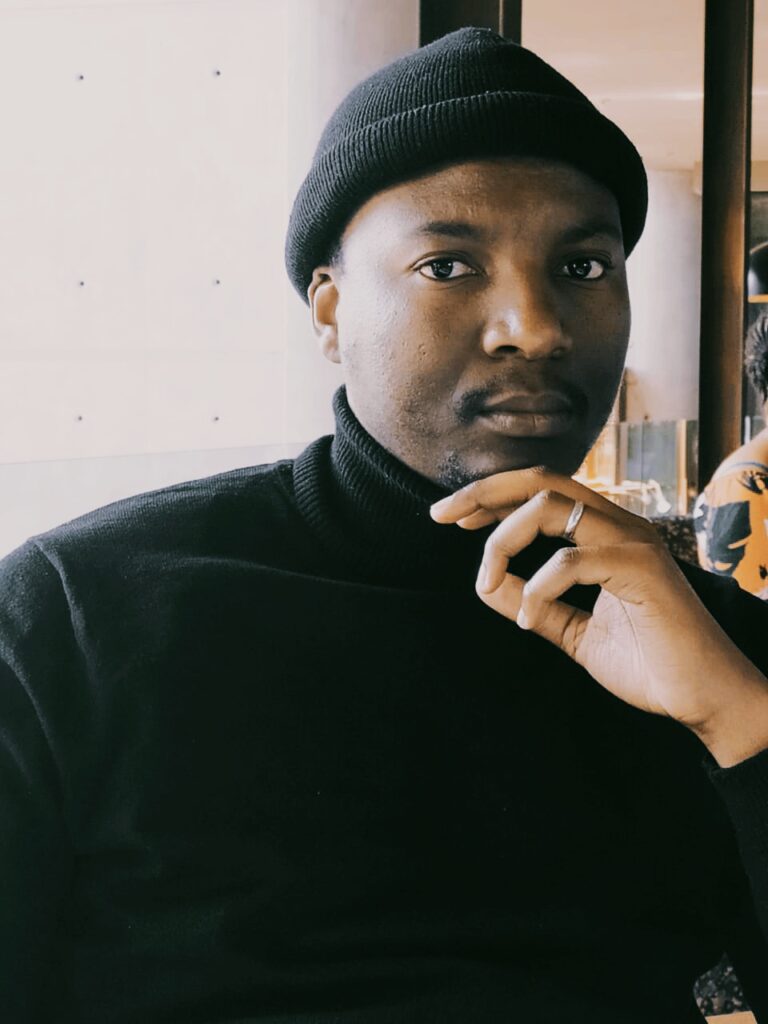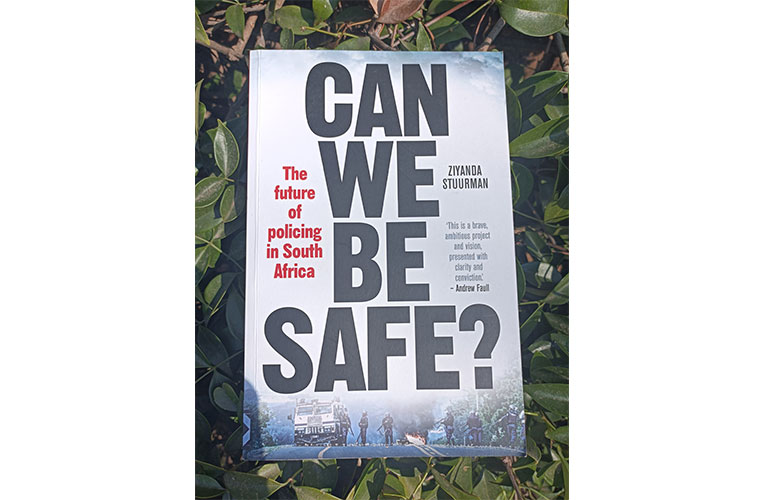Sensitive human-centric approach to all citizens could be answer to curb toxic relations between police and communities, a new book suggests
Author: Ziyanda Stuurman
Title: Can We Be Safe? The Future of Policing in South Africa
Publishers: Tafelberg (2021)
Review: By Roland Simpi Motaung

As of 2020 according to Population World Review some of the safest countries in the world include Iceland, Canada and New Zealand. Of course due to historical and social contexts, South Africa is vastly different from these countries.
But, what if we also had less tension between income groups due to the existence of equal economic opportunities and fair justice? Imagine a well-resourced and highly effective police service that puts people’s rights and safety at the center. Sadly though this is a very foreign portrait to our nation’s reality.
Like many South Africans (I hope) the safest I have felt in police presence is when going to a police station either for an affidavit, to open a case number or to certify certificates. But I digress. What has placed South Africa as one of the unsafest countries in the world?
In her recent book Can We Be Safe? The Future of Policing in South Africa, powerhouse activist Ziyanda Stuurman relays a brutal picture that we are far too familiar with as she fearlessly unpacks the history, present and future of the South African Police Services (SAPS).
In the book’s introduction Stuurman explores concepts of “police reform, the outcomes of colonialism and apartheid, our political history of negotiated settlement in the early 1900s to the 1990s and the concepts of human rights-based policing and community policing.”
Stuurman emphasizes that there is a deliberate “criminalization of poverty” and violence brought to most Black, Coloured and Indian communities by the police. In an attempt to curb such, the book advocates for a more “profound and transformative approach” that is more human-centric, rooted on the Freedom Charter and to a larger extent the Constitution. Where did it go wrong?
The history of colonial policing is that “police forces everywhere were created to protect privatized property” writes the author. In other words the police were uniformed bodyguards of white supremacy with crime detecting and prevention mandates being furthest from their minds.
Seen as threats to the segregationist status quo Black, Coloured and Indian people were monitored for any resistance activities. And yes you guessed right, nothing much has really changed. Cosmetic changes in uniforms, name and leadership structure in democratic South Africa over the years have not necessarily brought any fundamental changes to the police sector.
A cacophony of former Apartheid police officers, South African Defense Force (SADF), arm struggle wing members and new recruits has made it hard for all to be in sync with the new human rights approach. Racial tensions and ideological conflicts between the old ways vs. respecting human rights have created an impasse in delivering basic police services to growing communities.
Toxic relation between police and communities
Growing up in Mabopane, a township outside Pretoria, police were revered including my late father who was a detective at Ga-Rankuwa Police Station, another township outside Pretoria. However like in many other areas across the country the growing late responses and callousness shown to growing criminality forged a sense of mistrust of the police.
Eventually and sadly, communities did not only grow suspicious of the police but also of other community members. Like a toxic relationship between family members, the police and communities treat each other with disdain. Mistrust leads to resentment and anger where police respond with violence instead of kindness, human-ess and co-operation.
Lack of such cooperative efforts from both parties then tends to exacerbate toxic relations to a point of no return as we are seeing currently through the handling of service delivery protests in poor Black communities for instance.
To be fair however, due to the police’s current mental models mostly crafted by colonial and Apartheid ideologies, most may not even know what good policing should look like. They don’t have positive references to find inspiration thereby making the mental shift a difficult task granted if they were aware and willing to change.
The author further comments that police officers “are ultimately thinking and feeling human beings just like the rest of us and live in the same communities that we do.” The major difference of course is the inherited bias and impulsiveness of grabbing for power. It’s this constant hunger for power that also leads to a perpetuated toxic relationship with communities. On the one hand police forcefully demand “respect” through exerting violence mostly to Black communities, then community members retaliate as a form to regain their own power.
To avoid such selective policing and racial bias the author suggests showing “restraint and caution” and weighing up options before resorting to violence, something displayed before by police in white populated areas like Senekal, Brackenfell and Muizenberg.
In other words a more sensitive human-centric approach offered to all citizens, not just a White minority, may be one of the ways to curb such toxic relations. Human-centered justice ecosystem: A more human-centered justice ecosystem: police, courts and prisons is also needed, the book affirms. Courts are still racially and class biased offering unequal justice as its still rooted in colonial and Apartheid laws. To ensure fair justice Stuurman contends for alternative approaches such as restorative justice and civil justice through class action lawsuits.
Although these measures have their own flaws, restorative justice could be something to be considered as it promotes collective responsibility and reconciliation. Further, prisons should be places for rehabilitation and “correcting ” criminal behavior, not a pool to reproduce more criminals especially with the grooming of Black male youth sadly detained for petty crimes.
In essence a more social and human-centered method across the justice system could go a long way in ensuring real justice and for real criminals to be reformed instead of punishing the already disenfranchised members of society.
Where to from here? Possible solutions.
Reports from the Khayelitsha Commission and Farlam Commision have offered plenty of recommendations but as usual implementation from the government is slow. For instance the Farlam report was released March 2021 after a three-year delay by Police Minister Bheki Cele. The report detailed 136 recommendations including public order policing processes, accountability and demilitarization. Some of the apexes of the arguments presented echo the call for the demilitarization of the police force. In the 1920s the police were highly militarized in an effort for the British government to protect their private properties from growing Afrikaner nationalists and the rest of the population, this strategy worsened in the 1940s when Apartheid government took the driver’s seat.
A police militarization strategy is ineffective and short-sighted particularly dealing with gang violence in places like Cape Town and Nelson Mandela Bay, thus a better use of the military in supporting police services (or complete abolishment of strategy) is what the author asserts. Resource allocation such as well-trained detectives, vehicles and police stations are very irrational, unequal and unfair. Although equal allocation of resources to all areas is necessary, there are intangible issues with the police sector that must also be dealt with. Issues such as police corruption, administration efficiencies and lack of empathy for victims (particularly gender-based-violence victims) may not be fixed with more resources.
Thus a more practical approach is needed such as ethical leadership training, domestic violence training workshops, and establishing more victim friendly rooms at police stations – something that may also deal with the toxic patriarchal elements within the department.
Other suggestions include funding and empowerment of community policing forums, tech-savvy solutions through public/private partnerships with private security companies, broad-based cooperation between police and powerful civil organizations like Social Justice Coalition and Abahlali baseMjondolo. Conclusion and Recommendations For the most part this contribution mainly painted a negative picture of the police that we already know.
There was a missed opportunity to give case studies of good police work in South Africa or from other emerging countries that could serve as a template for both police and communities to use.
Without a doubt Stuurman has delivered a skop ‘n donner analysis of the South African Police Services. The book is an urgent demand for police to shoot out words of kindness and kill instead of the Apartheid mentality, where police will not see daughters and sons fighting for their rights to education as an act of hooliganism and where police will not see mothers and fathers trying to put food on the table as swart gevaar criminals.
Of course the levels of crime and violence in South Africa are symptomatic of bigger socio-economic issues troubling us. Fixing the police sector may not necessarily fix those issues.
I wonder if indeed all is lost because it can be argued that some communities still respect the SAPS institution. Thus there might still be hope for a wholesale mental shift from a colonial police- centric approach to a more community or social approach driven by ethical leadership so as to move us closer to a safer environment.
.Roland Simpi Motaung is a Johannesburg based writer, academician and entrepreneur.











Thank you for engaging so deeply, honestly and personally with the book Roland. I appreciate the time you took to write the review and to share your impressions of it.
Dear Academian, thank you for this review, certainly makes me want to read Ziyanda’s book, more so to make sense of my experience.
I was arrested a couple of weeks ago. The charge: “failer to wear musk in a public space.” After spending the entire day in detention, and having to pay a lawyer to represent me in a court of law in an attempt at avoiding a criminal record, it is the voices of the cops that remain with me. How they reiterated their objective of having me locked up because I am “too smart for your own good.”
I take this away from your review: “It’s this constant hunger for power that also leads to a perpetuated toxic relationship with communities. On the one hand police forcefully demand “respect” through exerting violence mostly to Black communities, then community members retaliate as a form to regain their own power.” And leave you with Binyavanga: One day, I too will write about this place.